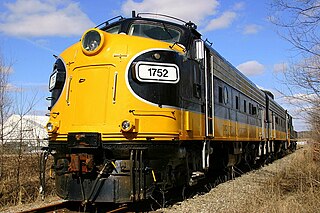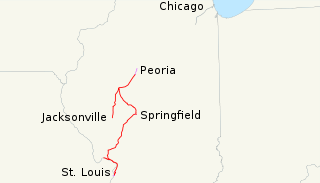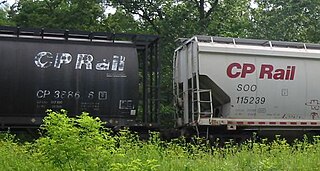
The Grand Trunk Western Railroad Company is an American subsidiary of the Canadian National Railway operating in Michigan, Illinois, Indiana and Ohio. Since a corporate restructuring in 1971 the railroad has been under CN's subsidiary holding company the Grand Trunk Corporation. Grand Trunk Western's routes are part of CN's Michigan Division. Its primary mainline between Chicago, Illinois, and Port Huron, Michigan, serves as a connection between railroad interchanges in Chicago and rail lines in eastern Canada and the Northeastern United States. The railroad's extensive trackage in Detroit and across southern Michigan has made it an essential link for the automotive industry as a hauler of parts and automobiles from manufacturing plants.
The Tennessee Central Railway was founded in 1884 as the Nashville and Knoxville Railroad by Alexander S. Crawford. It was an attempt to open up a rail route from the coal and minerals of East Tennessee to the markets of the midstate, a service which many businessmen felt was not being adequately provided by the existing railroad companies. They also wanted to ship coal and iron ore to the Northeastern US over the Cincinnati Southern Railway, which was leased to the Southern and operated as the Cincinnati, New Orleans and Texas Pacific Railway [CNOTP], through their Cincinnati gateway. The N&K was only completed between Lebanon, where it connected to a Nashville, Chattanooga and St. Louis Railway branch from Nashville, and Standing Stone.

The Georgia and Florida Railway is a short line railroad operating in Georgia and Florida, and is a subsidiary of OmniTRAX. The railroad spans 297 miles (478 km) over numerous different rail lines, most of which radiate out of Albany, Georgia.

The St. Louis Southwestern Railway, known by its nickname of "The Cotton Belt Route" or simply Cotton Belt, is a former US Class I railroad which operated between St. Louis, Missouri, and various points in the states of Arkansas, Tennessee, Louisiana, and Texas from 1891 to 1980. In 1980 the Cotton Belt began operating the Rock Island's Golden State Route which added the states of Kansas, Oklahoma, and New Mexico to the operation. Operation of the Cotton Belt was assumed by parent Southern Pacific in 1992.

The Alabama and Tennessee River Railway is a shortline railway operating over trackage formerly operated by CSX Transportation. The line's western terminus is a junction with the CSX main line in Birmingham, Alabama, near CSX's Boyles Yard. The eastern terminus is Guntersville, Alabama, near the Tennessee River. The parent company of the ATN is OmniTRAX, a major operator of American and Canadian short lines.
The South Omaha Terminal Railway in Omaha, Nebraska was a subsidiary of the Union Stock Yards Company of Omaha. Until the separate railroad company was created in July 1927, the trackage, about 17 miles (27 km), was owned and operated directly by the Union Stock Yards Company of Omaha. On April 4, 1978, an Interstate Commerce Commission emergency service order was issued at which time the Brandon Corporation took over service.
Established in 1908, the Stockton Terminal and Eastern Railroad provides service to several companies around the Stockton area, in San Joaquin County, California.

The Keokuk Junction Railway Co., is a Class III railroad in the U.S. states of Illinois and Iowa. It is a subsidiary of Pioneer Railcorp.
The Gateway Eastern Railway is a railroad subsidiary of the Kansas City Southern Railway (KCS), owning a 17-mile (27 km) main line between East Alton and East St. Louis, Illinois, United States. Originally created in 1994 as a subsidiary of the Gateway Western Railway, which acquired the East St. Louis-Kansas City line of the Chicago, Missouri and Western Railway in 1990, it was acquired by KCS along with its parent in 1997.

The Burlington Junction Railway is a Class III short line railroad which was chartered in 1985. Originally operating on the southernmost 3 miles (4.8 km) of the former Burlington, Cedar Rapids and Northern Railway mainline in Burlington, Iowa after abandonment by the Chicago, Rock Island and Pacific Railroad, it provides short freight hauling, switching operations, locomotive repair, and transloading services, the latter currently handling over 3,000 carloads a year. Typical commodity types transported include chemicals and fertilizer. The BJRY's primary interchange partner is the BNSF Railway.

The Central New York Railroad is a shortline railroad operating local freight service along ex-Southern Tier Line trackage in the U.S. states of New York and Pennsylvania. The line begins at Port Jervis, following the West Branch Delaware River to Deposit and the Susquehanna River from Lanesboro, where it crosses the Starrucca Viaduct, to Binghamton. It is a subsidiary of the Delaware Otsego Corporation, which also owns the New York, Susquehanna and Western Railway, operator of through trains over the line.
The Alliance Terminal Railroad is a Class III terminal railroad in Haslet, Texas, responsible for the switching and operations of the Alliance Intermodal Facility. It is owned by OmniTRAX and subleases the terminal yard from Quality Terminal Services, also owned by OmniTRAX. It connects with the BNSF Railway at Haslet, and operates on approximately 24 miles (39 km) of BNSF's track through incidental trackage rights.

The Chicago, Peoria and St. Louis Railroad (CP&StL) was a railroad in the U.S. state of Illinois that operated a main line between Pekin and Madison via Springfield. Its property was sold at foreclosure to several new companies in the 1920s; the portion north of Springfield has since become the Illinois and Midland Railroad, while the remainder has been abandoned, except for a portion near St. Louis that is now owned by the Norfolk Southern Railway.
The following is a brief history of the North American rail system, mainly through major changes to Class I railroads, the largest class by operating revenue.
The Manufacturers' Junction Railway is a shortline railroad operating six miles of track near Cicero, Illinois. The railway is owned and managed by OmniTRAX, a company offering railroad management and other related and unrelated services. MJ connects with the BNSF Railway, CSX Transportation, Canadian National Railway, and the Belt Railway of Chicago.

The Wabash Railroad was a Class I railroad that operated in the mid-central United States. It served a large area, including track in the states of Ohio, Indiana, Illinois, Iowa, Michigan, and Missouri and the province of Ontario. Its primary connections included Chicago, Illinois; Kansas City, Missouri; Detroit, Michigan; Buffalo, New York; St. Louis, Missouri; and Toledo, Ohio.
The lines of the Canadian Pacific Railway operated in the State of Maine were set up as a separate company to comply with Interstate Commerce Commission regulations and were considered a Class I U.S. railroad. The company operated 234 miles in Maine.











